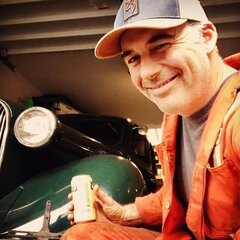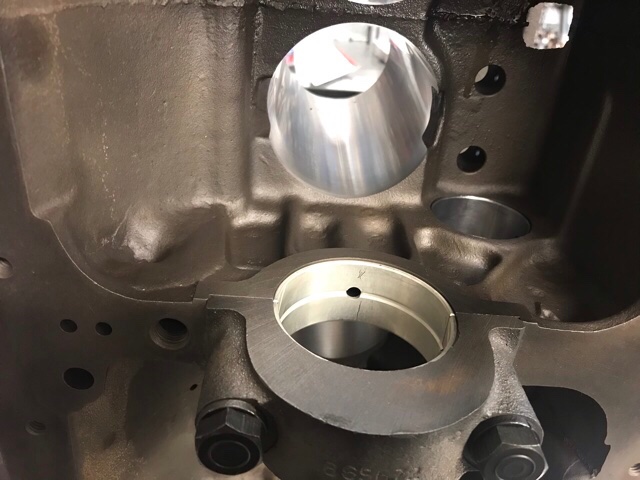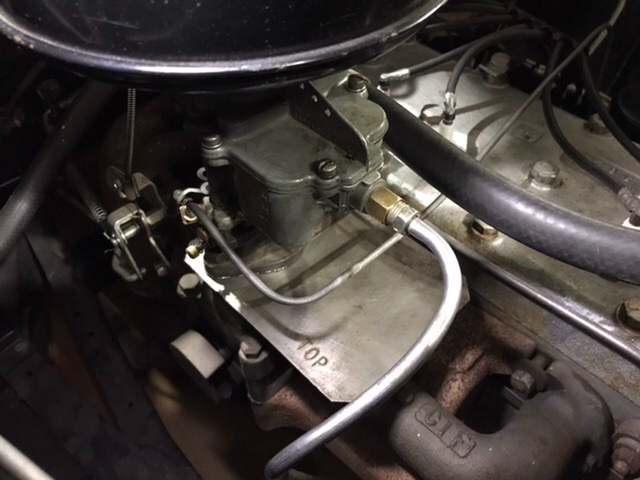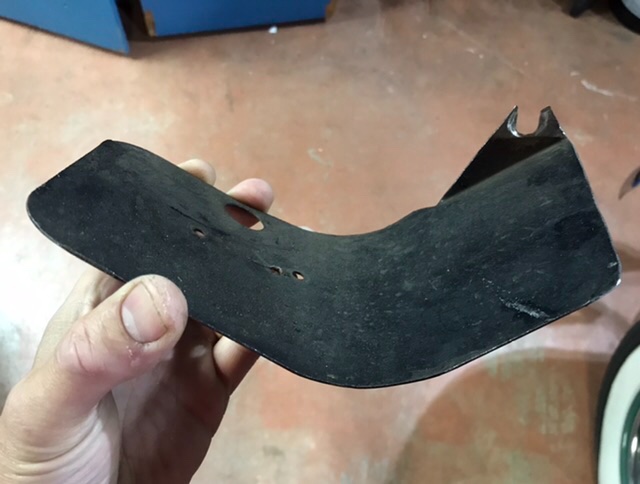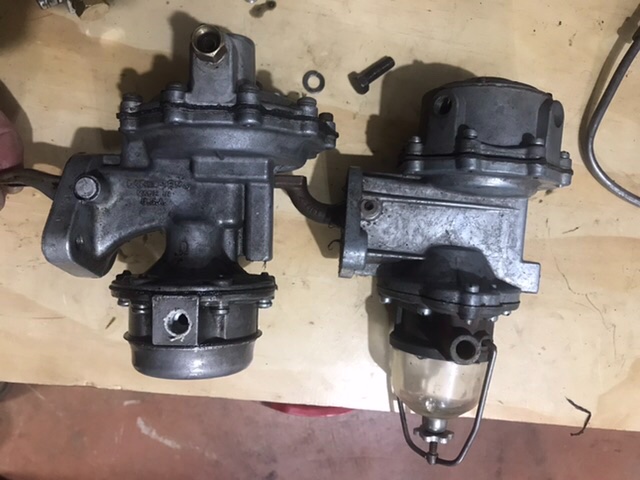-
Posts
3,462 -
Joined
-
Last visited
-
Days Won
193
Content Type
Links Directory
Profiles
Articles
Forums
Downloads
Store
Gallery
Blogs
Events
Everything posted by keithb7
-
I have the same parts book however mine is dated Jan 1 1938. Mine says "Preliminary Parts List" on the cover. It states this: "The information in this Part List covers both US and Canadian built cars. Parts for US built cars are the same unless otherwise specified." Looking at the drag link, there is 1 part shown the LH drive tube. 663886. RH drive tube is 663892. The Nov 1938 parts book above clearly specifies the changes along the production year. For whatever reason? Who knows. My 1938 CDN Plym P6 is SN 9351836. An early one I assume. My 201 engine that came with the car had a date code on the block of Nov 1938. My drag link is the earlier style that threads over the top of the rod. My car was made in Canada.
-
My ‘38 Plymouth wasted no time filling the Windsor’s spot back inside the garage again. It’s a considerably smaller car. I’ve gained some good room to reassemble it's engine. The Windsor has been very good to us. Many great memories for my family. It will always be remembered fondly. Even when it broke down it got us home. It never once needed a tow truck. Good old American iron. Both of my cars remaining Mopars are 1938. Made in Canada. Befitting I'd say. I wonder if they ever crossed paths on the production line?
-
Edging closer to wrapping up this thread. My ‘53 is loaded up for delivery. Going to her new home soon. A new owner anxiously awaits her arrival. She’ll be spoiled again and well taken care of for years to come.
-
Welcome. Buy a replacement?
-
I estimate that the membership here, like me, might enjoy the look of a fresh clean block. I dropped in at the local machine shop today for an update. Regarding my 1938 Plymouth engine. It will be a 25” 237 ci engine. Progress report includes all work complete but crank mains to be cut. I will pick up everything on Wed evening as it will be complete. Then I can start building it back up. Partial list of work includes: .005 off the head. Block deck was skimmed. Valve grind. Rods checked and true. New valve guides. 228 ci bored over to stock bore 237 ci. New block plugs. New timing sprocket on the crank. Etc etc. Getting excited again for this one!
-
I struggled a little with the same two bolts.
-
Feels like we are in the middle of summer above the arctic circle here today. Brr. Cold and windy. I put some MMO in all the cylinders and fuel tank today. I’ll start driving it this week and continue with treatments, until it’s attitude improves. I’ll continue to focus on cylinder #2 long term. A have faith it’ll free up. Will try the fuel cap vent idea. The Chrysler is exhibiting many similar fuel issues as my ‘38 Ply last spring. I only have so much time to poke through every possible improvement on the car. So it takes a while. I’m confident at some point I’ll have it dealt with. The 6V auxiliary pump is a sure winner. Pretty sure I’ll be going there. Worked great for my Plym. The only reluctance I have is all the comments I hear about others with similar Mopars with no issues in 100 degree heat. No auxiliary electric fuel pump. Running cheap ethanol fuel. No carb base heat plate. No phenolic spacer. All stock....I’m skeptical. Had I not been idling for 30 mins in stop and go traffic at 95F, I’d have been fine last week. I am pretty sure I could easily flash up my car and drive in 100F temps at regular speeds. 30 MPH and up, normal driving, and I’d have no problems about vapor lock either. It’ll all be sorted. I appreciate your comments and support....In time grasshopper. In time it will all be done.
-
A lot of the issues I am dealing with on my '38 Chrsyler are due to the car sitting so much over the past 25 years. 7000 total miles since the engine and entire car was rebuilt. We've all heard it before, cars were not meant to sit. They certainly deteriorate. I'm seeing some of those results now. Today I will purchase some Marvel Mystery Oil. Put a little in each cylinder, crank the engine over, and let it sit overnight. I'll put some MMO in the fuel tank and then start driving it. I'll perform a complete valve set. Then see what happens to the compression over the next 500 miles or so. Good chance it'll come up I think. I'll see if I can round up a boro-scope too to have a look down in the cylinders. Worst case scenario it's not a big deal to pull head and manifolds next winter if needed. Lap them valves up nice and pretty. Have a look at cylinder walls in #2 then plan out next steps. In the mean time, I've had a lot of fun and gained more great experience dealing with what this car has thrown at me so far.
-
Yesterday I removed the distributor and inspected everything. Seems good. Centrifugal weights and springs, vacuum advance, points, ground wires etc, all good and functioning. I gave the breaker plate bearing a shot of lube. Everything seems good. I replaced the condenser only, and then went for a test drive. The engine performed better yet again at higher RPM's. The car keeps improving as I complete things one step at a time, followed up with a test drive. Still, it's not right just yet. I still think it should be idling and running smoother. Today I finally completed a compression test. 1 through 6 seen here: 100 75 90 87 90 87 90 Something is going on with #2. With the wet test #2 went up to 90 psi. Planning now to go in for a full valve set. Fingers crossed I can get that cylinder up. The engine is not consuming any oil. Indications are the engine was rebuilt 7,000 miles ago. Which is why up to this point, I was chasing almost anything but a compression test. Perhaps a post engine break-in valve set was never done? We shall see.
-
Base plate heat sink shown. No it wasn’t a thing in 1938. However like radial tires, I believe some small advancements are advantageous for the old car. This heat plate can’t hurt, right? If properly installed for vacuum routing. Also see pic of my fuel pump heat dam. Its going to be installed tonight.
-
Is it the dry hot weather up here? How could it be that the same heat related symptoms follow me and every old Mopar car I own? Must be the mechanic causing these problems! ? I attended a cruise this afternoon in my '38 Chrysler. 95 F (35 cel) ambient temp. Sunny hot afternoon. Long lines of vintage cars out cruising together through town. 200 or so cars. Lots of slow idling through town. Everything under the hood was getting pretty warm. I tried to go up a hill in town. Low speed, heavy load. Engine was bucking and wouldn't rev up. Not enough power to climb the hill in first or second gear. I turned the car around. I left the group of cruising cars. I coasted down some down-hill roads and drove some flat roads. I got my speed up. Everything started to cool down again. Engine power restored within minutes of faster travel speeds. I made it up the steep long hill home without incident. Some facts: - Non-ethanol fuel 94 octane. - Stock 1953-era Mopar mechanical fuel pump that I rebuilt last year. Works fine. - Fuel pressure regulator removed -New Spark plugs -Carb Float set to spec -Heat sink plate at base of carb installed -Timing at spec. 0 deg TDC Was I vaporizing fuel? I suspect so. How so, with non ethanol fuel? I am inching closer to just going full electric fuel pump. The same heat related issues seem to plague me with each old Mopar car here. Yet other folks in this group drive in 110F heat in Texas with a mechanical fuel pump and have no issues. I will carry on trouble shooting and get this dialed in one way or another.
-
That’s interesting. That’s new to me. I’ve not seen an old Mopar rear seal like that before. Stock engine in your ‘50 Windsor? Sorry I can’t help. Hopefully someone will chirp in.
-
I’ll wait and hopefully place an order at a later time when I need multiple items. The ordering of one thing here and there leads to considerable increased costs. I have other options too once the Can/USA border opens up again. I’m stalling as we get closer each week to re-opening.
-
Thats not a rear main seal. Thats a splash/dust cover I believe. If oil is dripping out of it, it’s because the rear main engine seal is just above that piece in your photo. Oil from the rear main seal drips down on it, the drips off it, to the ground.
-
I hovered over the fuel/vacuum rebuild kit purchase button at Then & Now. Freight costs stopped me. I Did not order it. I am defiant and stubborn. Sorta fed up with freight charges. I know I’m only punishing myself. Then Now probably gets 30X the business from within the USA, compared to whiny Canadians. Tonight I removed the incorrect fuel/vacuum pump and the regulator. I installed the mechanical pump from my ‘38 Ply. Its down anyway. I am still waiting for second coming, before they finish my block machining work. I found the fuel flex line hose located on the cross member near the rad, going to the fuel pump, had a straight barbed fitting. Straight up. Then the hose bent and made a 90 degree turn toward the fuel pump. It was not a pre-formed hose so it had a folded kink in it. I installed a 90 degree fitting, new flex hose and hooked it to my mechanical pump. I ran out time to test new fuel pressure. Stock style regular old mechanical pump. If I recall it was about 4 psi after I rebuilt it for my Plymouth. I then went for a test drive. Pretty good. Runs fine. No dead spot off idle. Yet still, a stumble is there. I’m now thinking ignition or valve set. I’ll tackle those 2 next. One at a time to prove what it was. It t’werent the fuel pump or fuel pressure. A few pics from tonight’s work.
-
Good summary. Lots of work done there. You have the desire and energy, it’ll go. You’ll make it so. You are seen as fortunate by many here, to live within the USA and be able to readily get parts at reasonable prices. These old cars are tons of fun to work on. You’ll reap the rewards. I’ve been tinkering on my old Mopars tons and I quite enjoy it. I am rewarded every time I spin the starter over and head out for a drive.
-
I am ordering the rebuild kit from Then & Now tonight. I’ll rebuild the pumps when the kit arrives. I rebuilt the fuel pump on my ‘38 Ply. It seems to be reliable. This pump in my Royal looks pretty straightforward so I’ll give it a go myself.
-
@Plymouthy Adams MTBF? Mean time between frustration? Lol. I assume it means mean time between failure.
-
@chrysler1941 Yes, I need to ditch that regulator. In order to remove the regulator I need to get the stock pump rebuilt and back on the car. Part of the problem is, there is limited time to address everything I'd like to on the car. Plus I need to acquire a rebuild kit to rebuild the original fuel pump. I am doing research now on pump kits. I see a kit on the "Then & Now" web site. I'll dig out the old original pump to disassemble, inspect and compare parts before ordering a new kit. That'll take a 2-3 weeks at best before the rebuild kit arrives. In the mean time I'll endure what I have on the car. I have a list of things that I want to address on the car. Plus I want to drive and enjoy it in the meantime. I have been getting a lot of work done. Each passing week I check off more items on the list. I am chiseling away at the car, making it better. Working full-time for a living really cuts into my garage time!
-
Cool Car @Worden18. Congrats on the find. I'm sure you'll drive the heck out of it.
-
I put the Cat seals in my 38 Plymouth. I did not take any measurements of the seal to record.
-
The more I dig in I, keep finding more interesting stuff. At the red arrow, on the top of the accelerator pump spring, the round brass retainer cover was absent. Under the screw-in cover seen at the green arrow. Down in there is an accelerator pump discharge check ball. The ball was there but someone had a fine small spring jammed between the screw-in cover, and the check ball. That spring would have been forcing, retaining the ball down into it’s seat. According to my paperwork its not supposed to be there. More test driving. It keeps getting better. High RPM still feels a little off. During test driving I am hearing a little backfire on occasion too. Seems to happen only on deceleration. Not often. Adjusting timing seems to have no effect on the high rpm stumble or a backfire. Might be lean on fuel? Adjusting float had no effect either. Hmm. New points and condenser are on the menu. Those parts in the car are well worn and of unknown time in service. Replacement is part of my overall ground-level reset. Might as well put those in next and see what develops. Then go from there.
-
Test drive results: Dead spot just off idle is gone. Great results. I am losing a some power at high rpm. I can feel it. On another web site a member mentioned that the Holly fuel pressure regulator will cause a leaner condition. If that’s true, maybe I’ll set the float to be a little richer. Maybe the bowl can’t deliver enough fuel at high load and rpm. I’ll play with my timing a bit first. I been screwing with it a fair bit over the past few days troubleshooting. Getting closer!
-
Troubleshooting, finding and fixing this stuff is so fun. Rewarding. Addicting. It gives me a little natural high. Some Purpose. It Feels good. This small win exemplifies pretty well, why I am into old cars. Fingers crossed this find and fix offers some improvement!
-
Aha. More clues. A definite air leak here at the carb mounting adaptor plate. 2 points for Mr Desoto Hartung.


